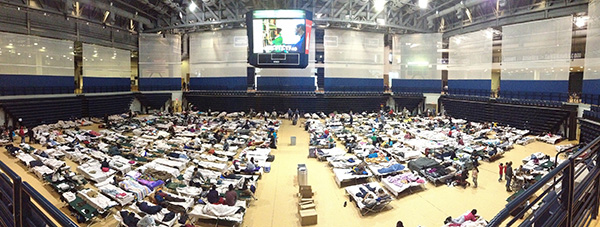
By Melissa Ziobro
It’s been almost 10 years since Super Storm Sandy swept ashore in New Jersey. For some in Monmouth County, the extended power outages and inconvenient gas shortages that were the extent of their Sandy experience seem a distant memory. But there are homeowners who still have not rebuilt after the storm’s devastation.
The process of developing a path forward following the destruction Sandy wrought, and then navigating that path, was more often than not unbelievably stressful, lengthy and expensive for both government officials and scores of impacted homeowners, many of whom had never imagined their properties might flood.
Since 2016, I’ve been conducting oral history interviews with these government officials and impacted homeowners, along with first responders, nonprofit leaders, social workers and more, all intended to document the experience of the historic storm in the words of those who lived it. These interviews are roughly one hour long each. They are transcribed and preserved, in full and unedited, for the historical record.

My interviewing began in advance of the fifth anniversary of the storm, while working with the Monmouth County Historical Association (MCHA) on the original exhibit “Tracking Sandy: Monmouth County Remembers.” That exhibit assessed storm preparations, the science behind the storm, the role of first responders, community efforts, rebuilding, and Monmouth County’s preparations for future emergencies, weather-related or otherwise. Guest-curated by me in collaboration with MCHA Board President Linda Bricker and then MCHA Interim Executive Director Chuck Jones, and designed by Stan Cain, the exhibit opened Oct. 29, 2017 at MCHA’s headquarters in Freehold. Portions of the exhibit are now on permanent display at the Monmouth County Sheriff’s Office complex in Freehold.
This summer, I conducted a second round of interviews in advance of the 10th anniversary of the storm, funded by Monmouth University’s Urban Coast Institute. This growing collection of recordings and transcripts creates an invaluable record for generations to come, adding to our understanding not just of Sandy as a historic event, but potentially contributing to conversations on themes like coastal resilience, climate change, environmental justice, public/private partnerships, and emergency preparedness. I am so grateful to the narrators who took the time out of their schedules to help us record history in the words of those who lived it. Especially laudable are the impacted homeowners who bravely revisited what was for many a very traumatic ordeal. As we approach the 10th anniversary of Super Storm Sandy, may we all remember the resiliency of Monmouth County – but also the power of Mother Nature and the need for preparedness.
Melissa Ziobro is a specialist professor of public history at Monmouth University’s Department of History and Anthropology.
How Sandy Became a Super Storm
Sandy began as a hurricane and was dubbed a super storm when it made landfall in New Jersey. The storm’s origin, according to the National Hurricane Center (NHC), was “primarily associated with a tropical wave that left the west coast of Africa” Oct. 11, 2012. The wave entered the eastern Caribbean Sea early Oct. 18. The NHC’s Hurricane Sandy Advisory Archive shows Sandy-related warnings issued beginning Oct. 22.
Six days before Sandy hit Monmouth County, a computer program based in England known as the European Centre for Medium-range Weather Forecasting (ECMWF) predicted the storm would make landfall somewhere between New Jersey and New York City Monday, Oct. 29. At that point, most of the other models in use at the NHC in Miami, including the US Global Forecast System (GFS), had Sandy veering away from the Atlantic Coast and staying far out at sea.
Forecasters showed various models until four days before the storm hit, when the other models came to mirror the ECMWF. Emergency management officials in the northeastern U.S. had days to prepare as Hurricane Sandy tore through the Caribbean, peaking as a category 3 storm.
In New Jersey, then Gov. Chris Christie declared a state of emergency Saturday, Oct. 27 and issued an evacuation order for the barrier islands by 4 p.m. Sunday, Oct. 28. Monmouth County and local municipalities issued their own emergency declarations and evacuation orders.
Meteorologists, politicians and millions of Americans in the storm’s path watched and waited to see if Hurricane Sandy would turn out to sea or hit the Eastern Seaboard?
As Tony MacDonald, director of Monmouth University’s Urban Coast Institute noted in an oral history interview, “… it really took a very unusual and dramatic left hand turn as it came up the coast.”
Sandy weakened somewhat in windspeed before making landfall as a post-tropical cyclone near Atlantic City at approximately 8 p.m. Oct. 29. Though not technically even a category 1 hurricane at this point, the massive storm – which would come to be known as a super storm – had historic low pressure and drove a catastrophic storm surge into the New Jersey and New York coastlines. Monmouth County saw record-breaking storm surges in excess of 13 feet in Amazingly, there was no loss of life directly attributed to the storm in the county.
“I think that was because of our constant messaging about evacuation, our ability of messaging and education for preparing and knowing where you live and being able to react accordingly some places,” said Monmouth County Sheriff Shaun Golden after the storm.
No loss of life, perhaps, but the county saw billions of dollars in property damage. As Sea Bright resident Karen Finkelstein recalled post-storm, “Things were not recognizable because there were sand dunes in Ocean Avenue and things were covered with sand and cars had been dispersed all over… everything that had been in our living room, it looked like it had been in a blender and was just swirled around and there was water and I couldn’t understand it.”
“I could see on the walls this stain where the high-water mark had been in our house,” Finkelstein said. “And you could tell it had a turbulent force, too, it because it had wave marks and the refrigerator was on the floor; things that you’d think would stay standing.”
– M.Z.
Reflections: A Series of Events on Sandy’s Legacy
Several free, public events at Monmouth University Oct. 27 and 28 will explore the history and legacy of Super Storm Sandy in Monmouth County in advance of the 10th anniversary, as many ponder the future of coastal living in an age of increasingly severe weather.
To Build or Not to Build: That is the Question – Lessons We Haven’t Learned 10 Years after Super Storm Sandy, Oct. 27, 1:30 p.m.: Monmouth University Urban Coast Institute Director Tony MacDonald will moderate this special conversation with New Jersey Department of Environmental Protection Commissioner Shawn LaTourette, Climate Central senior advisor Don Bain, and Federal Emergency Management Administration Region II Mitigation Division director Michael Moriarty. The event will be held in Monmouth University’s Great Hall Auditorium with a livestream option via Zoom.
Documenting and Interpreting Super Storm Sandy, virtual panel, Oct. 28, noon: This virtual panel will explore some of the ways Super Storm Sandy is being documented for the historical record and interpreted for the public. Panelists include Professor Karen Bright, MFA, Department of Art and Design, Monmouth University; Molly Graham, oral historian, National Oceanic and Atmospheric Administration (NOAA); and Abigail Perkiss, Ph.D., associate professor of history at Kean University and author of the new book, “Hurricane Sandy on New Jersey’s Forgotten Shore” (Cornell University Press, 2022). The panel will be moderated by Melissa Ziobro, specialist professor of public history at Monmouth University and project lead for Tracking Sandy: Monmouth County Remembers, a multiyear effort to document the impacts of Super Storm Sandy in Monmouth County via oral history collection and public exhibits.
The Jersey Storm: Sandy in Monmouth County, film screening, Oct. 28, 1:30 p.m.: Directed by Adam Worth and produced by Monmouth County Clerk Christine Giordano Hanlon, “The Jersey Storm” features never-before-seen footage taken in the aftermath of Sandy and interviews with the Monmouth County officials, first responders, and residents who lived through it. The film chronicles Sandy and the fortitude of the local heroes who sprang into action in its wake. Monmouth specialist professor of public history Melissa Ziobro provided guidance on the project and UCI associate director Thomas Herrington appears in interviews. The movie will be screened in Monmouth University’s Pollak Theatre.
Tracking Sandy: Monmouth County Remembers, student poster exhibition, Oct. 28, 3 p.m., Join specialist professor of public history Melissa Ziobro’s Museums and Archives Management Basics students as they unveil a poster exhibit that pairs excerpts from oral history interviews with archival photos in order to document and interpret Super Storm
Sandy’s impact on Monmouth County. Open through December 2022 at the Monmouth University Guggenheim Memorial Library.
See more about all events at monmouth.edu/uci
The article originally appeared in the October 20 – 26, 2022 print edition of The Two River Times.














